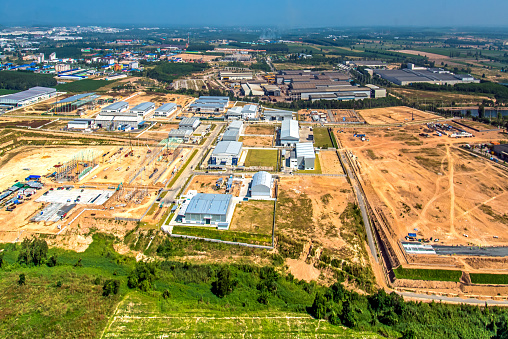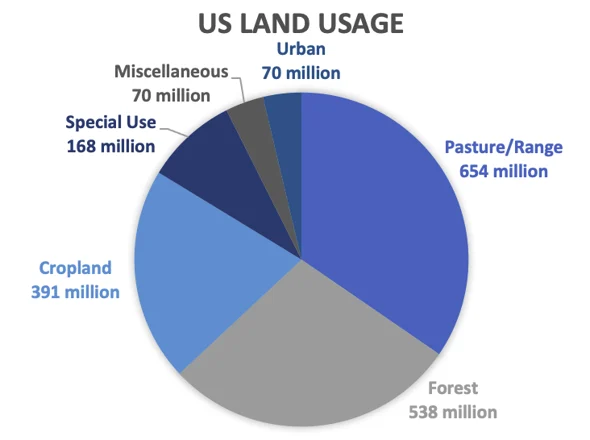Navigating the new world of land acquisition and project siting
What do the following have in common?
A pipeline right of way, an electric transmission line, a producing oil well, a renewable energy solar farm, a petrochemical facility, a carbon sequestration farm, an intrastate highway, and a railroad
If you guessed they all require land to operate, you were correct.
You would think with approximately 1.9 billion acres of land in the lower 48 states of the U.S. there is ample undeveloped land for future development and new enterprises. But is that the case? Think about this: Have you recently found yourself competing for prime acreage with other industries on one of your projects? Has the cost of land acquisition been higher than projected because you underestimated the value of the current use or income stream of the property you are negotiating? If you answered yes to either of those questions, do not feel alone. Many land professionals, including myself, have experienced both in the past several years.
Are you planning for the future?
As land professionals and project developers we become so engulfed in the budgeting, permitting, and execution of our projects that we often overlook or minimize the most important element of the project, the land in which the operations will take place. As the population of the US continues to grow, currently around 331 million people and estimated to grow to 435 million by 2050, so does the demand for land development. While only 70 million acres of the U.S. is currently considered urbanized, a large percentage of our projects are concentrated near these areas to be closer to the market in which they serve. With the rate of 1 million acres of land being converted to urbanization annually, many projects are not budgeting realistic values on properties that in the not-so-near future will be swallowed by urban sprawl. The fact that your project area is located 50 miles from the city limits and is currently in crop production no longer means the current owner will be willing to negotiate the sale or long-term use of the land for current rural cropland rates. There is no one more educated and in tune with the potential revenue streams from land than today’s landowners. They are now, more than ever, weighing their options before executing land-related contracts. Project site acquisition can no longer be evaluated and budgeted by using the traditional methodology of how the land is currently being used and the current value as of today. Instead, landowners are expecting to be compensated for what is being taken from the land in a lease scenario, or the loss of future revenue or appreciation in a sales-type contract.
So where did all that land go?
Before we get too much further down this rabbit trail, let us take a quick look at how the 1.9 billion acres of land in the U.S. is currently being used.

According to the U.S. Department of Agriculture, land use in the United States can be placed in six categories:
- Pasture/Range
- Forest
- Cropland
- Special Use
- Miscellaneous
- Urban
More than one-third of U.S. land, approximately 654 million acres, is currently used for pasture to raise livestock. The second-largest land use, 538 million acres, is in forest lands (in which 11 million acres of timber is harvested annually). There are approximately 391 million acres in cropland, with 127 million acres grown for livestock feed, 77 million acres for the food we eat, and 38 million acres for ethanol or biodiesel production. The special use category totals 168 million acres and consists of 64 million acres of Wilderness areas, 29 million acres of National Parks, 25 million acres of National Defense lands, 21 million acres of rural highways, 15 million acres of State Parks, and 8 million acres in airports, golf courses, and railroads. The Urbanized areas of the U.S. totals 70 million acres. While this is only 3.6% of the total size of the 48 contiguous states, 80% of Americans live or work in these areas. The remaining 70 million acres fall in the miscellaneous category which consists of wetlands, rural residential lands, non-harvestable timber, desert, etc.
As you can see, over the past century we have identified the best use and developed revenue streams for much of the acreage in the U.S. What might seem like vast open spaces or vacant lands to some, are in fact the lands that raise our food, produce the raw materials to build our homes and structures, and hold the resources necessary to sustain and grow as a nation. There are no longer any undeveloped lands in this Country and as we continue to grow and develop as a Nation, we are only moving acreage from one category to another. As the population continues to increase, so does the demand on our resources. While this may not seem to be a huge issue in the short term, at some point there will be a tipping point wherein we lose the balance between growth and sustainability. This is becoming even more evident as we continue to see significant increases in land prices across the country, especially in the areas within proximity to urban sprawl.
So, what does this all mean for land professionals and the projects in which we work?
It is our responsibility to do our part in maintaining the balance required to sustain population growth and be better stewards of the lands and resources in which we develop. The days of focusing solely on the sector in which we work and securing more lands or rights than are required are coming to an end. Not only for sustainability and stewardship reasons, but also for economic reasons. Since many of us work within the public sector, or on projects that are subjected to commodity pricing, the substantial increase in land values will require us to be more selective in how we negotiate and acquire land rights, or many projects will no longer be economically feasible. A single tract of land can support multiple enterprises and if developed wisely will reduce the land acquisition cost and allow the landowner to produce multiple revenue streams from the property, all while regenerating resources for generations to come.
Stacking Enterprises
Stacking enterprises and allowing multiple revenue streams on a tract of land will require land professionals to have a much broader understanding of all property ownership rights within the project area and the knowledge to draft, negotiate, and execute contracts accordingly. Land professionals will need to understand how their proposed operations will affect further development and accommodate for future non-obstructive enterprises across the property. This is accomplished by contracting for only what is needed for the project. Dependent on the type of project we are developing, this will require us to evaluate and question project parameters such as:
- Is it necessary to acquire a 25 foot right of way or is 10 feet sufficient?
- Can the contracted area revert to the current landowner at end of use?
- Must the easement traverse through the middle of the property, or can it be moved to the boundary?
- Is it possible to accommodate for the current use of the property to be continued (i.e. farming or livestock production)?
- Can the project be designed and built to allow for future resource development?
- Is it possible to identify and stack the new project on a similar non-competing developed project?
 These are all the same project parameters we have been discussing and addressing for years, but the difference is we have not challenged them to the level that is required today. We are all guilty of approaching certain guidelines or tasks with the mindset of “that is always how it’s been done” and there is a good possibility that what worked yesterday will not be acceptable today. Successful project acquisition will now depend on our ability to maximize the revenue potential of the tract for the landowner while realizing financial savings on acquisitions for the project.
These are all the same project parameters we have been discussing and addressing for years, but the difference is we have not challenged them to the level that is required today. We are all guilty of approaching certain guidelines or tasks with the mindset of “that is always how it’s been done” and there is a good possibility that what worked yesterday will not be acceptable today. Successful project acquisition will now depend on our ability to maximize the revenue potential of the tract for the landowner while realizing financial savings on acquisitions for the project.
As a wise man once told me “Land is the one thing we cannot make more of.” It is our responsibility to be good stewards of these lands and all the resources they provide. If done properly we can ensure they will be available for generations to come, while realizing economic savings in our projects as we do.
I have been employed with Percheron, or one of the legacy companies thereof, as a land professional for the past 27 years. For those of you who may not be familiar with the company, Percheron is a land services company that provides title, land acquisition, lease administration, GIS, survey, environmental, and engineering services across many markets. Being employed at a company like Percheron has given me the opportunity to work and gain knowledge in oil and gas exploration, mineral development, midstream right of way acquisition, electric transmission and distribution, public transportation, renewable energy development, carbon sequestration, above and below ground storage, and renewable natural gas. All of which are markets the company serves. Working with such a diverse mix of markets and being associated with and around the most knowledgeable individuals in each of the industries, has allowed Percheron to successfully complete some of the most complex projects to date. As land acquisition continues to become more complex and competition for prime acreage increases, it will be imperative that your in-house land staff is well versed across many markets, or better yet you can entrust your project to Percheron to help navigate these new waters.
Need help navigating this new world of land acquisition and project siting? Give us a call at 832.300.6400 or email Jeff at
Jeff Trlicek is a Managing Partner for Percheron, LLC. He brings over 29 years of experience in the energy industry. He also serves on the Board of Directors of Percheron.
Jeff has extensive experience working in title insurance, mineral title, lease acquisition, geophysical permitting, renewable project development, and project management of large-scale energy projects, responsible for hundreds of projects across numerous end markets. Starting in 2012, he served as Vice President of the Energy division for Percheron, a position he held until April 2020, when he was named Managing Partner of Renewables.
